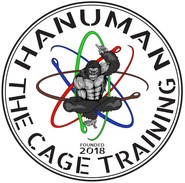

FITEDUCATION is pleased to present Hanuman The Cage Training
A new training method characterized by the tool, "the cage" innovative and versatile able to effectively complete the free body training in all its facets and training methodology that represent the link between all disciplines of the world of fitness and movement as a whole. Developed by Jari Ranzato, multiple Italian champion of competitive aerobics, international presenter and master trainer of various fitness disciplines, it is based on the use of a large metal structure (similar to a cage, in fact) to perform a wide range of different movements and exercises. Shared by the same vision of innovation, seriousness and joy for the movement, he shares his experience as a teacher and presenter of FITEDUCATION led by the great Sayonara Motta, presenting together this latest innovation as a functional and conscientious training. Thanks to a common intent with Angelo and Danilo Mattellini of THEPOLE, producers of the tool with a new engineering vision HANUMAN THE CAGE TRAINING becomes shape-shifting thanks to the engineering system smart & safty that changing the insertion points of the bars modify the shape making it possible to work with various R.O.M. facilitating the success of specific elements.
How to use Hanuman The Cage Training and what are its training potentials.
The tool
"The cage" is a solid structure in the shape of a large parallelepiped, consisting of horizontal and vertical metal elements, perpendicular and parallel to each other, differently positioned on its various faces nor constitutes a central core and four other external stations: each element constitutes a point of support or backing for those who use it, offering seven different levels from bottom to top, allowing them to perform an almost infinite range of free-body exercises," explains Ranzato, through the archetypes of movement, that is, the mathematical geometric operators of symmetry which are: rotation, translation, change of dimension, the mirror plane or center of inversion (mirror vision)
The vertical axis is the vector of energy, I move up + difficult, I move down - difficult. The horizontal axis is the vector of time: I rotate counterclockwise, sx past (rotation on the axis to the rear), I rotate clockwise to dx future (rotation on the axis to the front) or movements to the left or right his frontal plane, unless one is left-handed and will interpret such information inversely. The sagittal axis is the vector of space: the translation of a segment can go in one direction or the other, it can travel the space in one direction or the other, positive or negative direction, + or -, I come towards you (+ close), I move away from you (- close). And a fourth operator which is the plane of symmetry or center of inversion (mirror plane, mirror vision). This great tool is designed for gyms, because it can be used by a single person in a one-on-one work with the personal trainer, but also by several students at the same time, under the guidance of an instructor: in fact, it offers 4-5 stations to train together (direct circuit), to which you can add others outside the structure (indirect circuit), getting to involve about fifteen students. It is therefore perfect for lessons with small, medium and large groups according to the number of "cages".
The training potential
The methodology of work, whose full name is Hanuman the cage training, comes from in-depth studies in areas other than the strictly physiological and biomechanical, such as holographic virtual reality, geometry and quantum physics that take into account the most recent discoveries about the nature of man as a set of three consciousnesses: Soul, Mind, Spirit, which experience life through the container "body", which moves in Space, Time and Energy experiencing life through simple rules of symmetry. The HTCT method offers new interesting concepts that include and respect the already present principles of anatomy, physiology and biomechanics, enriching it through the discoveries of Prof. Corrado Malanga, derived from the study of quantum physics in relation to Consciousness but also beyond a scientific vision, to what has to do with psychology, cosmogony, spirituality and esotericism applied through the methodology Hanuman The Cage Training to training using the HTCT structure. This method focuses on the relationship between Consciousness, its emanation and man. That is the nature of the virtual, holographic and fractal universe and what its possibilities to operate, benefiting through the relationship between the movement and its properties, increasing the state of awareness of the Consciousness of Soul, Mind and Spirit and the related state of health at psychophysical level for the relationship with the main glands of man as the Pineal gland (Epiphysis), the Pituitary gland (Hypophysis), the Carotid gland (Thyroid) and the Thalamus.
"The 'cage' is a complete and effective training tool, because it can support in the execution of any kind of gesture, exploiting the three spatial dimensions and improving the motor awareness of the trainees that occurs through input and output data at the cerebral level through our triaxial cranial system (VAK) visual, auditory, coenesthetic. You can start from a standing position (even balanced on one foot), sitting or lying down, on top of the structure or next to it, and movements can be integrated (i.e. involve the whole body in a synergistic way) or isolate single areas, multi-articular or mono-articular, symmetrical or asymmetrical, slower, more dynamic or isometric" says its creator. In practice, by varying the position, the play of the body's levers and the movements around the equipment, all kinds of exercise routines are performed, with flexions, extensions, bends, stretches, twists. "The strong point is that all motor qualities are developed, bringing into play and thus training all the natural potential of our musculoskeletal 'machine'. And this happens without a moment of boredom, having fun and always adapting the workouts to the level of physical preparation of the students," suggests Ranzato.
Possible lessons
"The duration of the lessons varies from 30 to 60 minutes, with a prevalence of 45-minute sessions that allow for a fruitful succession of the classic phases of warm-up, actual training, and fatigue. However, depending on the type of exercises proposed and the rhythm kept, it is possible to build lessons with different purposes" specifies Ranzato. Very popular are the functional classes that include all the old formats such as those of tone-up that, in turn, can be total body or have as focus the GAG area, the upper body or the core. "But there are also classes focused only on stretching, postural, cardio and fat burning, and even yoga classes or, for the most trained students, even acrobatic sessions "Hanuman Flow" that blends the skills of calisthenics with fluid transitions using the specific points between one station and another of "The Cage" anticipates Ranzato.
1. Functional. "You work using circuit formats with multiple stations, combining very varied and diverse exercises," specifies the Trainer. Imagine hanging from a high bar: you can lift yourself up with pull-ups or, by turning your back to the 'cage', you can raise your legs in a team to work your abs. Leaning your hands on a lower tube, however, you can perform arm bends, keeping your head, torso and legs well aligned, or assume the plank position and alternately bring your knees to your chest in the so-called mountain climber.
2. Cardio training. These are lessons with a lively rhythm, based on jumps and jumps of various kinds. For example, you can stand inside the 'cage', place your hands on two parallel bars at hip height, assume the lunge position and perform exchanges, each time reversing the position of the legs with a jump. Or, outside the Cage, you can rest your hands on a bar in front of you (helping you with your balance) and perform a sequence of jumping jacks (opening and closing your legs), or squat-jumps.
3. Stretching. The Cage, in this case, is used as a wall bar or as the bar with which ballet dancers train, facilitating the holding of stretching positions that, without support, would be difficult. These positions are often simple, but profitable: for example, you place one foot on a high bar and keep the leg extended, bending the torso on the thigh, or you grab a vertical tube, opening the arm in a cross, and you make a screwing of the body on its axis, backwards, to stretch pectoral and biceps.
4. Postural. "Metal structures are also useful for sequences that realign the body, balancing its attitude," reveals Ranzato. An emblematic exercise is one in which you place your hands on a horizontal tube at waist level, bend your torso and assume an L-shaped pose, with arms and torso aligned and legs perpendicular to the ground: the effect is decontracting and rebalancing for the back.
5. Yoga. Even yoga classes find in the Cage a useful support to maintain the asanas with greater ease. "The bars represent references to be followed, so they allow better alignments of the body and more precise holds" points out the expert. Entering the 'cage' you can assume the Warrior II pose, helping yourself with the surrounding supports, or outside, starting from an L-shaped position with your hands resting on a tube, you can lift and align a leg behind to assume the Warrior III pose.
6. Acrobatics. These highly engaging and often dramatic work sessions are reserved for already trained users and rely on holds and movements borrowed from artistic gymnastics. "They require a great deal of body awareness, to be applied to exercises that use bars as one would use asymmetrical parallel bars, rings or pole dancing. There are the simple handstands, which are performed outside the 'cage' and use it as a support, the flips at a greater or lesser height from the ground, up to the more complex evolutions in which you move with fluidity from one position to another, up and down the equipment.
We will be waiting for you from Thursday to Sunday with NON Stop mini class.
To book just come to the desk in the Fiteducation Area PAD D3
